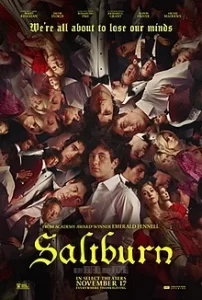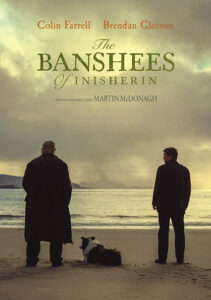Saltburn-2023
Director Emerald Fennell
Starring Barry Keoghan, Jacob Elordi, Rosamund Pike
Scott’s Review #1,417
Reviewed January 19, 2024
Grade: A
Emerald Fennell, as a director (she also acts) is someone to keep a close eye on. With only her second film, Saltburn (2023), she has quickly drawn comparisons to Darren Aronofsky and Yorgos Lanthimos by creating wickedly daring comedies rife with sharp dialogue and peculiar tastes.
Okay, I’m drawing those comparisons on my own.
The point is that she creates films that are not necessarily for mainstream audiences but will satisfy the peculiar cravings of those seeking left-of-center and hard-to-predict films.
She also wrote the screenplay.
Those wary of hard-to-digest scenes involving blood, sex, nudity, and other depravities, be forewarned.
Her first film was the revenge-themed and Academy Award-winning Promising Young Woman (2020) starring Carey Mulligan who makes a return appearance in Saltburn.
This time out Fennell offers us a beautifully daring story centering around privilege, jealousy, and desire. The film offers unlikable characters with enough twists and turns to keep the audience off guard and confused as to who to root for or against.
Will the characters we hate stay hated? If this sounds vague it’s because the film is filled with mystery.
Oliver Quick (Barry Keoghan) is an awkward young man struggling to find his place at Oxford University the recipient of a scholarship for those with financial hardships. His mother is a recovering drug addict and his father is dead.
Unpopular, he finds himself drawn to the charming and handsome Felix Catton (Jacob Elordi), who also happens to be filthy rich. Felix is the envy of almost everyone as they strive to be his friend or bedfellow.
After Oliver does Felix a favor, they become buddies, and Felix unexpectedly invites him to Saltburn, his eccentric family’s sprawling estate, for a summer vacation.
The lavish Oxford University is grandiose and scholarly with lots of preppy and wealthy intellectuals. As the snobs partake in parties and wild games Oliver is looked down on by everyone but Felix. The spoiled students are not meant for the audience to like.
I love how Fennell incorporates legions of insecurities suffered by the have-nots struggling to fit in which is a common theme of hers. The only kid willing to give Oliver the time of day is a creepy Jeffrey Dahmer type.
Anyone familiar with cliques on college campuses will be firmly in Oliver’s corner. He’s a good kid after all, who has been dealt a struggling hand at life, what with his parent’s issues and all.
The shit hits the fan when Oliver arrives at Saltburn which makes Oxford seem minimal in comparison. Manicured and sprawling lawns complete with a center maze are overwhelming to Oliver to say nothing of the group of oddballs that make up the family and staff.
Suddenly though, everything becomes weird, and the tone of the film shifts.
The final forty-five minutes are riveting with unexpected events transpiring after a wild party to celebrate Oliver’s birthday. Felix, his sister, and their parents are involved in shenanigans that make the viewers question everything they’ve seen thus far.
Mulligan doesn’t have much to do in Saltburn. Her role amounts to little more than a cameo which would be more irritating if the other characters weren’t so richly written.
Rosamund Pike and Richard E. Grant sizzle as aristocratic types oblivious to everyone else and their wealthy surroundings. It’s almost as if they assume everyone lives this well.
The sexual scenes of desire are breathtaking and startlingly explicit. In one scene, two characters make out with bloody mouths and in another, one character masturbates in a bathtub while another character spies on him and lustfully licks the faucet a few minutes later.
The best acting performance belongs to Keoghan who delivers a complex and spirited character who we’re not sure what will do next or sometimes why. He possesses an innocent yet creepy veneer which is tough to figure out.
His naked dance sequence is one of the wildest in cinema history.
Fennell hits another grand slam with the eerie yet fascinating Saltburn (2023), a delicious examination of the class system. The mixture of the groveling poor with the callous rich makes for a brilliant story.
I can’t wait to see what she does next.



